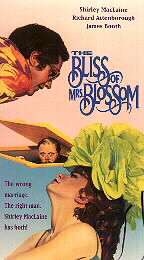The Bliss of Mrs. Blossom
| The Bliss of Mrs. Blossom | |
|---|---|
 Videotape cover | |
| Directed by | Joseph McGrath |
| Produced by | Josef Shaftel |
| Written by |
Alec Coppel Denis Norden Based on a short story by Josef Shaftel |
| Starring |
Shirley MacLaine Richard Attenborough James Booth |
| Music by | Riz Ortolani |
| Cinematography | Geoffrey Unsworth |
| Edited by | Ralph Sheldon |
| Distributed by | Paramount Pictures |
Release dates |
|
Running time | 93 minutes |
| Country | United Kingdom |
| Language | English |
The Bliss of Mrs. Blossom is a 1968 British comedy film directed by Joseph McGrath. The screenplay by Alec Coppel and Denis Norden was adapted from a play by Coppel that was based on a short story by Josef Shaftel, who served as the film's producer.
Plot
Robert Blossom is a brassiere manufacturer and workaholic. When his wife Harriet's sewing machine breaks, he sends his bumbling employee Ambrose Tuttle to repair it. Mrs. Blossom seduces him, then hides him in the attic, instructing him to sneak out in the middle of the night. Ambrose, however, is enchanted by the woman and decides to settle in to serve as her secret paramour. When he's reported missing, Det. Sgt. Dylan from Scotland Yard is assigned to the case, one he doggedly pursues for years. The mysterious noises Robert frequently hears overhead finally lead to his nervous breakdown, but Ambrose saves the day by passing along stock tips that turn his employer into a millionaire. The grateful Mr. Blossom not only allows Ambrose to remain with his wife, but presents the couple with his factory as a wedding present.
Story
The film is loosely based on a real incident. In the early 1920s, Walburga Oesterreich kept her lover Otto Sanhuber in the attic where he lived for many years. The real story doesn't have the happy ending of the movie.
Production notes
Joseph Shaftel said the script was based on a story of his, which in turn was based on a true story.[1]
Shirley MacLaine was a last minute replacement after the original star pulled out. Her fee was a reported $750,000.[2]
Assheton Gorton served as production designer for the film.
Location scenes were filmed in Bloomsbury, at the National Film Theatre in the South Bank Centre, and at Alexandra Palace in London. Interiors were filmed at the Twickenham Film Studios in Middlesex.
The soundtrack includes the songs "The Way That I Live" performed by Jack Jones and "Fall in Love" performed by the New Vaudeville Band.
Frank Thornton, Barry Humphries, Bea Arthur and John Cleese make brief appearances in the film.
Principal cast
- Shirley MacLaine ..... Harriet Blossom
- Richard Attenborough ..... Robert Blossom
- James Booth ..... Ambrose Tuttle
- Freddie Jones ... Det. Sgt. Dylan
- Bob Monkhouse ..... Dr. Taylor
- Patricia Routledge ..... Miss Reece
Reception
In his review in the New York Times, Howard Thompson called the film "roguish, restrained and absurdly likable, with a neat climactic twist."[3]
Variety described it as "a silly, campy and sophisticated marital comedy, always amusing and often hilarious in impact . . . although basically a one-joke story, [the] idea is fleshed out most satisfactorily so as to take undue attention away from the premise. Performances are all very good, Attenborough's in particular."[4]
Time Out New York calles it a "coarse comedy which looks a little like Joe Orton gone disastrously wrong . . . any sparks in the script or performances are ruthlessly extinguished by atrocious direction."[5]
References
- ↑ 'Sister George' Preens for the Movies: More About Movie Matters By A.H. WEILER. New York Times (1923-Current file) [New York, N.Y] 01 Jan 1967: 63.
- ↑ Alexander Walker, Hollywood, England, Stein and Day, 1974 p396
- ↑ New York Times review
- ↑ Variety review
- ↑ Time Out New York review